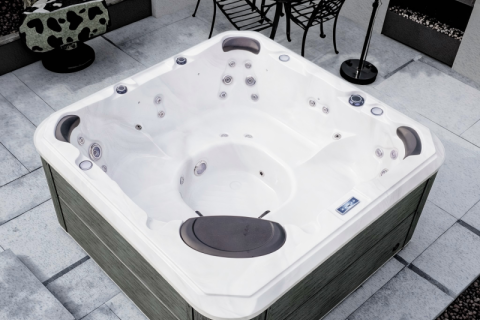
- Home
- >
News
• Step 1: Turn on the water quality tester and verify that the device's battery and settings are correct. Step 2: Immerse the device's probe or sensor in the water sample, ensuring that the probe is completely submerged. • Step 3: Wait for the instrument to stabilize and display the results. For some digital instruments, it may take from a few seconds to several minutes to obtain an accurate reading. • Step 4: Read the water quality results on the display. Record the pH, chlorine concentration, total alkalinity, hardness, and other indicators. If necessary, take notes or photos for backup. • Step 5: Take appropriate measures based on the test results. If any indicators are abnormal, add acid, alkali, disinfectant, or other agents as needed to adjust the water quality.
If you live in a cold area and want to minimize heat loss, a foam or synthetic rubber cover is a better choice; they effectively maintain the temperature of your hot tub water.
The most straightforward way to control water flow direction is with mechanically adjustable jets. Many high-end modern outdoor spa hot tubs are equipped with rotating jets (adjustable jets), which can be manually adjusted to change the direction of the water flow.
Steps for installing an outdoor spa hot tub disconnect box: 1. Disconnect the power supply 2. Install the disconnect box bracket 3. Connect the power cord 4. Install the protective device 5. Inspect the wiring after completion 6. Test the disconnect box 7. Power on and test
Acrylic has good heat resistance, but may experience slight thermal expansion in high-temperature environments. Generally, acrylic doesn't deform significantly when heated, but it may exhibit slight surface distortion or shrinkage if exposed to extreme heat for extended periods.
According to professional recommendations, the water temperature for infants in outdoor spa hot tubs should be between 37°C and 38°C. This temperature range is generally considered suitable for infants' skin and body temperature regulation systems.
When an outdoor spa hot tub is in standard mode, the system strives to maintain the set water temperature, which means the heater will activate frequently to compensate for heat loss. Energy-saving mode, however, does reduce electricity consumption by reducing the heater's operating time or power consumption.
There's no absolute answer; it depends on several key factors: · Will you continue to use your spa hot tub during the winter? · Are winters in your area severe enough to cause frequent freezing? · Can you guarantee reliable power and properly maintained equipment? · Can you afford to completely drain and winterize your equipment?
The chlorides and peroxides in pool shock have strong chemical activity. These ingredients may cause corrosion and damage to spa hot tub pipes, nozzles, heating systems and other equipment at high temperatures.
It is not recommended. Some ingredients in bath balls may cause the formation of a grease layer in the water, which will affect the heating efficiency of the spa hot tub. When there is an oil layer on the water surface, the heat may not be evenly distributed, making it difficult to regulate the water temperature stably.
Six weeks to three months after delivery (recovery period) During the six weeks to three months after delivery, the mother's body gradually recovers and the recovery process of the uterus gradually stabilizes. At this time, most mothers' physical strength, immune system, and hormone levels tend to be normal, and they can withstand proper body care and hydrotherapy activities.
——No, and it is not recommended to do so for a long time! The correct approach should include: · Always use the original heating system; · Regularly maintain the heater and filter; · Do not modify the circuit or directly cut off the power at will; · When changing water, a small amount of heating assistance can be used, but the temperature and injection method should be strictly controlled; · If there is a problem, contact the manufacturer or professional technician for repair in time to avoid secondary problems caused by artificial substitution operations.












